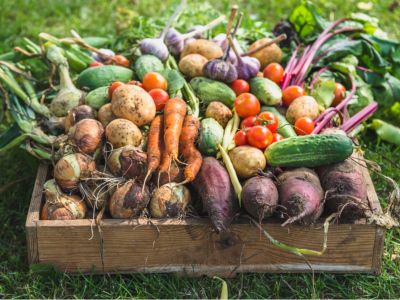Small Garden, Big Yield
If you’ve been gardening for a few years, it’s likely you’ve already been taking steps to increase garden yield. Practices like making compost and using it to amend the soil gives garden plants the nutrients they need to grow bigger and be more productive. Here are a few additional ways to improve soil quality for a bigger garden yield:
Grow a cover crop over the winter.Spread 1 to 2 inches (2.5 to 5 cm.) of manure or chopped leaves over the garden in the fall.Use compostable mulch, like straw or grass clippings, in the summer.
Switch to a High-Yield Garden Layout
What could be more aesthetically pleasing than a garden filled with perfectly straight rows of veggies? Unfortunately, row-style gardening creates excessive (and unproductive) aisleways. Thus, one of the best ways to increase garden yield is to ditch this romanticized notion of garden layout in favor of a more productive one. Luckily, there are garden planning apps available to help redesign the space and create a high-yield garden layout. When redesigning your garden, try incorporating these concepts into your new layout:
Raised or dedicated beds. Planting in blocks, as opposed to rows, reduces aisleways and allows gardeners to concentrate soil amendment efforts where plants are grown.Utilize vertical gardening. Using trellises for vining crops like tomatoes, pole beans, melons, squash and cucumbers is a space-saving technique. But it also raises these veggies off the ground, which keeps them out of reach of hungry critters and reduces ground rot issues for a bigger garden yield.Interplant. Increase garden yield with companion planting, such as the three sisters approach of growing corn, squash and pole beans together. Or plant fast-maturing plants, like leafy greens and radishes, between slow-growers. The short-season plants can be harvested before plants such as tomatoes or Brussels sprouts fill out.
Tips for Maximizing Garden Yield
Extending the growing season is another method for maximizing garden yield. Try these tips for getting the most out of your gardening space:
Jump-start spring planting. Spread black plastic over the garden and utilize the sun’s rays to bring spring soil up to an ideal temperature. Then plant seed crops 1 to 2 weeks earlier. Successive sow. Plant and replant quick-growers like lettuce, radishes and microgreens. This not only provides a steadier supply of these crops, but the same areas can be replanted multiple times per year.Alternate early spring and fall crops. Increase garden yield by planting peas, kohlrabi and turnips in the spring for an early summer crop, then utilize the same space for a fall crop of summer-bolting plants like spinach, bok choy and kale. Use row covers to protect these crops from the cold.Container Gardening. Plant earlier and protect tender crops from frost by moving potted veggies indoors at night. Try growing microgreens year-round in a sunny, southern window.
Finally, take the “small garden, big yield” concept to heart by choosing crops or cultivars which thrive in your area, providing proper plant care and guarding against pests and diseases. Since you’ve worked so hard in the garden this summer we want to show off the fruits (and veggies) of your labor! We invite you to join the Gardening Know How Virtual Harvest Show by submitting photos of your harvest!
